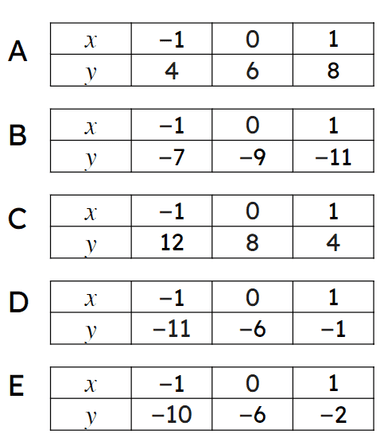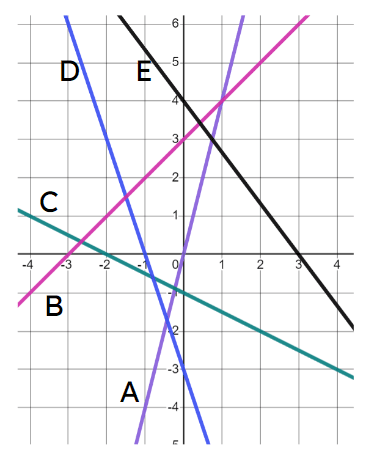Myths about teaching can hold you back


- Year 8
The intercept point
I can calculate the intercept point from a graph and from two coordinate pairs.


- Year 8
The intercept point
I can calculate the intercept point from a graph and from two coordinate pairs.
These resources were made for remote use during the pandemic, not classroom teaching.
Switch to our new teaching resources now - designed by teachers and leading subject experts, and tested in classrooms.
Lesson details
Key learning points
- The y-intercept can be found by considering the graph.
- The y-intercept occurs when the x value is zero.
- The gradient can be found from two points.
- The y-intercept can be found using the gradient and one of the points.
- It is useful to check using the second point while understanding the limitations of this check.
Keywords
Gradient - The gradient is a measure of how steep a line is.
Intercept - An intercept is the coordinate where a line or curve meets a given axis.
Linear - The relationship between two variables is linear if, when plotted on a pair of axes, a straight line is formed.
Common misconception
Writing the y intercept as a single value or getting the x and y coordinates the wrong way around.
Encourage writing the y intercept as a coordinate. Stating 'lines cross the y axis when x=0' can help pupils write the coordinate correctly.
To help you plan your year 8 maths lesson on: The intercept point, download all teaching resources for free and adapt to suit your pupils' needs...
To help you plan your year 8 maths lesson on: The intercept point, download all teaching resources for free and adapt to suit your pupils' needs.
The starter quiz will activate and check your pupils' prior knowledge, with versions available both with and without answers in PDF format.
We use learning cycles to break down learning into key concepts or ideas linked to the learning outcome. Each learning cycle features explanations with checks for understanding and practice tasks with feedback. All of this is found in our slide decks, ready for you to download and edit. The practice tasks are also available as printable worksheets and some lessons have additional materials with extra material you might need for teaching the lesson.
The assessment exit quiz will test your pupils' understanding of the key learning points.
Our video is a tool for planning, showing how other teachers might teach the lesson, offering helpful tips, modelled explanations and inspiration for your own delivery in the classroom. Plus, you can set it as homework or revision for pupils and keep their learning on track by sharing an online pupil version of this lesson.
Explore more key stage 3 maths lessons from the Graphical representations of linear equations unit, dive into the full secondary maths curriculum, or learn more about lesson planning.

Licence
Prior knowledge starter quiz
6 Questions
Q1.Which of these sequences are linear?
Q2.Which of these best describes an intercept point?
Q3.The tables shown have been labeled A,B,C,D,E. Match the table with the correct gradient.

A -
2
B -
-2
C -
-4
D -
5
E -
4
Q4.In a linear sequence the common difference is 3 and the tenth term is 32. What is the first term?

Q5.What is the gradient of the line which passes through the coordinates (4, 7) and (6,11) ?
Q6.What is the gradient of the line which passes through the coordinates (2, -6) and (0,-1) ?
Assessment exit quiz
6 Questions
Q1.What is the $$y$$-intercept for the line formed when this table of values is plotted?

Q2.Which of these coordinates could be a $$y$$-intercept?
Q3.The graph shows 5 lines labelled A, B, C, D, E. Match the line to its corresponding $$y$$ intercept.

A (purple) -
(0,0)
B (pink) -
(0,3)
C (green) -
(0,-1)
D (blue) -
(0,-3)
E (black) -
(0,4)
Q4.What is the $$y$$ intercept for the line belonging to this table of values?

Q5.What is the $$y$$ intercept for the line belonging to this table of values?

Q6.Match up the $$y$$-intercepts with the corresponding lines.
(0,-3) -
The line through (4,5) and (5,7)
(0,0) -
The line through (1,3) and (3,9)
(0,15) -
The line through (10,5) and (13,2)
(0,-15) -
The line through (4,-3) and (8,9)

